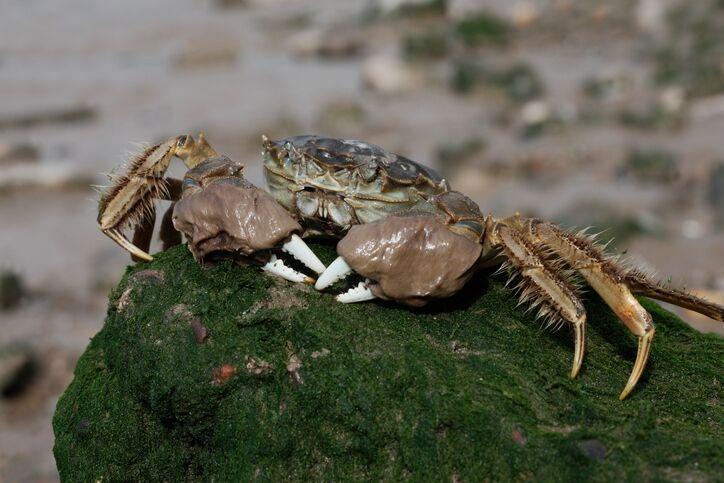MOST WANTED – Destructive Foreign Species That Are Destroying
Our British Waterways
This is a list of the most wanted unwelcome visitors in the
UK who have out stayed their visit to our British waterways. They have bullied
their way into our beautiful waterways and are ruining the natural habitat for
native species such as the water vole and the white-clawed crayfish to name but
two native species that are affected by their unwelcome presence.
WANTED: Chinese Mitten Crab

ORIGINS: Southeast Asia
WHEREABOUTS: Mainly in London on the river Thames where
they were first spotted over 70 years ago, Medway and Ouse. Also seen and
recorded at other site throughout England and Wales, including the rivers Tyne,
Tamar and Dee and Southfields Reservoir near Castleford, Yorkshire.
IDENTIFICATION: A large crab with a maximum carapace (body)
length of 56 mm. Olive green in colour with paler legs, which are twice the
length of the body. The most obvious distinguishing feature of the Chinese
mitten crab is the dense mat of hair on the claws which look like mittens!
CRIME: Their extensive burrowing damages canals, drainage
embankments and structures. Known to eat just about anything that crosses its
path. It is also capable of leaving the water and crossing dry land to enter
new waters.
IF SIGHTED: Contact
the Environment Agency fisheries, who conduct regular trappings in an attempt
to stop the spread.
WANTED: Red-Eared Terrapin
ORIGINS: Transported from the USA as pets during the Teenage
Mutant Hero Turtles cartoon craze of the 1980s. They became a problem when
released into the wild as unwanted pets.
WHEREABOUTS: The Midlands and Southern England sport the
largest terrapin populations.
IDENTIFCATION: The
average length ranges from 15 to 20 cm (6 to 8 in). The females of the species
are usually larger than the males. They usually live between 20 and 30 years
CRIME: The waterways were a safer place
for birds eggs and insect larvae before their appearance .
WANTED: American Signal Crayfish
ORIGINS: North America
WHEREABOUTS: Seen throughout England
IDENTIFICATION: 15cm-long beasts. They are bluish-brown to
reddish-brown in colour with robust, large, smooth claws. They have a white to
pale blue-green patch near the claw hinge, like the white flags that signalmen
used for directing trains—hence the name.
CRIME: They are aggressive and breed faster than the native
species. They also carry a fungal disease
‘crayfish plague’ which is harmful to our native species. Lastly they are
responsible for damaging the banks with their burrowing.
IF SIGHTED: Commonly
caught in waterways of southern England using rod and reel. If caught signal
crayfish must be removed from waterway and killed.
WANTED: Zander
ORGINS: Eurasia
WHEREABOUTS: Found in slow flowing waters in Central
England
IDENTIFICATION: It has a wide-mouth, excellent vision and
fang-like teeth. Have an average length of 40–80 cm (16-32 inches) with a
maximum length of 120 cm (47.25 inches).
CRIME: As a non-native predatory fish it has a big impact on
other native coarse fish species.
WANTED: Zebra Mussels
ORIGINS: Eastern
Europe. These stripey stowaways landed in Britain’s waterways on the hulls of
ships from Eastern Europe and decided to stay.
WHEREABOUTS: Across
the UK
IDENTIFICATION: Zebra
mussels get their name from the striped pattern of their shells. However, the
pattern varies greatly to where there are no stripes, only dark or light coloured
shells. Zebra mussels can grow to a maximum length of about 50 mm (5-10 mm in
the first year) and live four to five years.
CRIME: These nautical
nuisances reproduce rapidly and form large colonies that attach to almost any
submerged hard surface, impeding the smooth running of canal gates and sluices.
They can spread easily as their larvae move through canals and rivers like cars
on a motorway network. The invading mussels also kill British native freshwater
mussels. If the zebra mussels get into water treatment works, they can block up
the whole system.
WANTED: Sunbleak Fish
ORIGINS: Native to
continental Europe but not the UK
WHEREABOUTS: Found in rivers and lakes throughout Somerset,
Hampshire and also in Dorset.
IDENTIFICATION: A small fish, usually less than 9cm
CRIME:They compete with native species as they have similar
diets and spawning areas, can be infected with parasites and are regarded as a
pest to anglers.
WANTED: Topmouth Gudgeon
ORIGINS: Asia
WHEREABOUTS: Found in waterways across England and Wales
IDENTIFICATION: I Measuring up to 9cms in length, the males are
usually darker in appearance than the females. The interloper could pass itself
off as a sardine in a identity parade
CRIME: It breeds at four times the rate of native fish and
it can also breed up to four times a year. Known to spread parasites and
beating native species to food and habitat, it also eats the native fish’s
eggs. It can breed up to four times a year.
IF SIGHTED: The Environment
Agency fisheries staff conduct regular electro-fishing of affected waterways in
an attempt to stop the spread and eradicate this fish.
WANTED: Mink
ORGINS: America
WHEREABOUTS: Throughout Britain’s waterways and can also
spend time out of the water in urban areas.
IDENTIFICATION: Has brown or black fur and is between 30-60cm
in length with a slender body and short legs. They are smaller than an otter.
CRIME: Initially brought to Britain in 1929 for commercial
fur farms. Since the release into the wild during the 1950s they have breeding
extensively in the wild.
SITUATION: Mink
numbers have started to decline as our native otter population recovers. Otters
are reported to attack and even kill mink which it seems is helping to reduce the numbers.